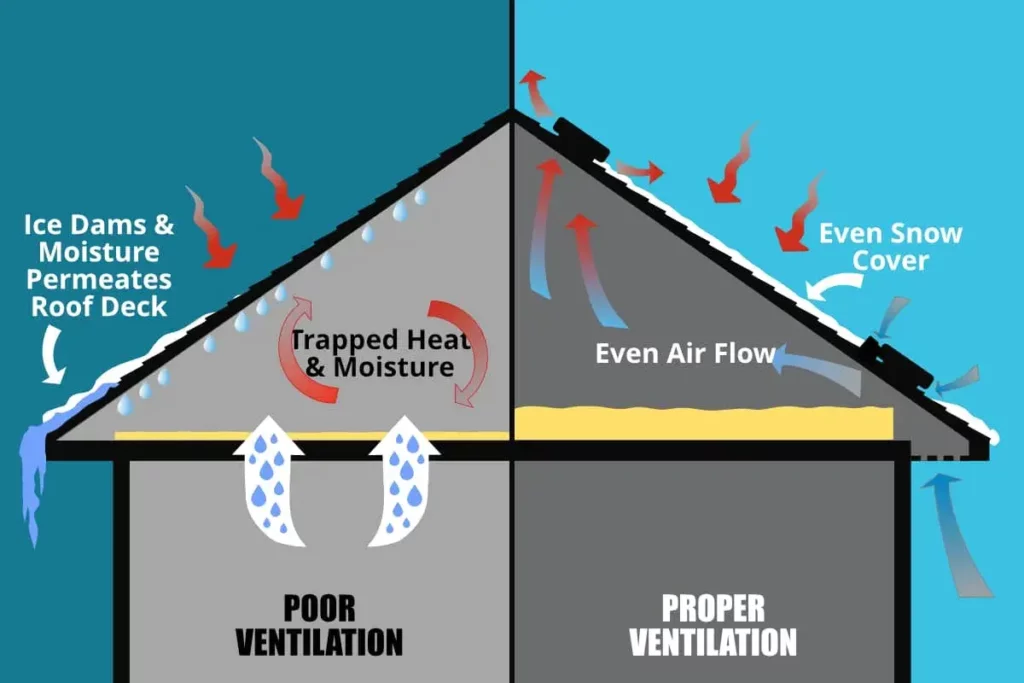What Is The Most Effective Type Of Roof Ventilation?
Proper roof ventilation is essential for any home or building to ensure comfort, energy efficiency, and longevity. Effective roof ventilation can help regulate temperature and humidity, prevent moisture buildup and mold growth, reduce energy consumption, and extend the life of roofing materials. But with so many types of roof ventilation available, how do you know which one is the most effective for your building? If you are unaware and confused then consult with Expert basement waterproofing providing top-notch services at affordable prices.

Most Effective Types of Roof Ventilation
The most effective type of roof ventilation depends on several factors, including the size of your home, the climate in your area, and the type of roofing materials used. In general, a combination of both intake and exhaust vents is recommended for proper roof ventilation. Here are some of the most effective types of roof ventilation:
Ridge Ventilation
Ridge ventilation is one of the most effective types of roof ventilation available. It involves installing a vent along the ridge of the roof, which allows hot air to escape from the attic or roof space. This type of ventilation is effective because hot air rises and ridge vents allow it to escape naturally. Ridge ventilation is particularly effective for buildings with high-pitched roofs.
Gable Ventilation
Gable ventilation involves installing vents in the gable walls of a building. This type of ventilation is effective for buildings with a triangular roof shape. Gable vents allow hot air to escape from the attic or roof space while drawing cool air in from the eaves.
Soffit Ventilation
Soffit ventilation involves installing vents in the soffit, the underside of the eaves. This type of ventilation is effective because it allows cool air to enter the attic or roof space while pushing hot air out through the ridge vent or other types of vents.
Turbine Ventilation
Turbine ventilation involves installing a turbine vent on the roof. The vent has fins that spin in the wind, drawing hot air out of the attic or roof space. This type of ventilation is particularly effective in areas with strong winds.
Roof Ventilation Fans
Roof ventilation fans are electrically powered fans that are installed on the roof. These fans draw hot air out of the attic or roof space and can be particularly effective in areas with low wind speeds.
Static Ventilation
Static ventilation is a type of roof ventilation that does not require any powered fans or motors to operate. Instead, it relies on natural air movement to draw hot air out of the attic or roof space and replace it with cool air. Static vents are installed on the roof or in the attic and come in various shapes and sizes, such as ridge vents, gable vents, and soffit vents.
Dormer Ventilation
Dormer ventilation involves installing vents in dormer windows, which are windows that protrude from the roof. This type of ventilation is effective for buildings with dormers, as it allows hot air to escape from the attic or roof space.
Cupola Ventilation
Cupola ventilation involves installing a cupola on the roof. The cupola is a dome-shaped structure with vents that allow hot air to escape from the attic or roof space. This type of ventilation can be particularly effective for buildings with flat roofs.
Solar Powered Ventilation
Solar-powered ventilation involves installing vents that are powered by solar panels. These vents draw hot air out of the attic or roof space using a solar-powered fan. This type of ventilation is particularly effective for buildings in sunny climates.
Power Attic Ventilation
Power attic ventilation is a type of roof ventilation that uses a powered fan or motor to draw hot air out of the attic or roof space and replace it with cooler air. The powered fan or motor is typically installed in a vent on the roof, and it is connected to a thermostat or humidistat that turns the fan on and off based on temperature or humidity levels.
There are several types of power attic ventilation, including roof-mounted fans, gable-mounted fans, and solar-powered fans.
Benefits of Roof Ventilation
Effective roof ventilation can provide several benefits for your home, including:
1: Improved Energy Efficiency:
Proper roof ventilation can help regulate temperature and humidity levels in the attic or roof space, reducing the amount of heat that is transferred to the living space below. This can help reduce cooling costs in the summer and heating costs in the winter.
2:Extended Roof Lifespan:
High temperatures in the attic or roof space can cause shingles and other roofing materials to deteriorate more quickly. Proper roof ventilation can help prevent this by reducing the buildup of heat and moisture, which can extend the lifespan of your roof.
3:Prevention of Mold and Mildew Growth:
Excessive moisture in the attic or roof space can lead to the growth of mold and mildew, which can cause health problems and damage to your home’s structure. Proper roof ventilation can help reduce the buildup of moisture and prevent mold and mildew growth.
4:Improved Indoor Air Quality:
Poor roof ventilation can lead to the buildup of harmful pollutants in your home, such as carbon monoxide and radon. Proper roof ventilation can help reduce these pollutants and improve indoor air quality.
5: Enhanced Comfort:
Proper roof ventilation can help regulate temperature and humidity levels in your home, providing a more comfortable living environment for you and your family.
6:Reduced Roof Repair Costs:
Proper roof ventilation can help prevent damage to your roof caused by moisture buildup, reducing the need for costly repairs.
Conclusion
In conclusion, choosing the most effective type of roof ventilation for your building depends on various factors, such as the building’s shape, size, and location. It’s important to consult with a trusted professional, consider searching for “best ventilation services near me” to find reliable contractors in your area.
Expert basement waterproofing services, along with foundation repair services, and basement waterproofing issues. Remember, there are three types of basement waterproofing: interior sealants, exterior waterproofing, and interior water drainage. Consider consulting with an expert to determine the best solution for your specific needs.

